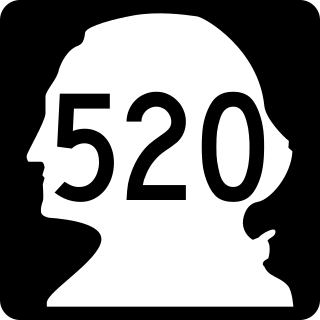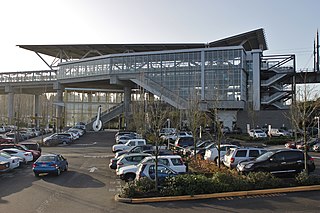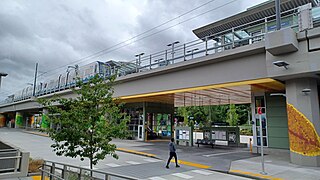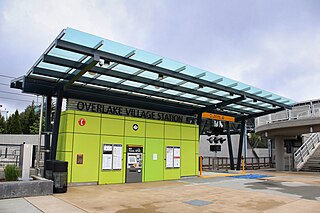
Bellevue is a city in the Eastside region of King County, Washington, United States, located across Lake Washington from Seattle. It is the third-largest city in the Seattle metropolitan area, and the fifth-largest city in Washington. It has variously been characterized as a satellite city, a suburb, a boomburb, or an edge city. The population was 151,854 at the 2020 census. The city's name is derived from the French term belle vue.

State Route 520 (SR 520) is a state highway and freeway in the Seattle metropolitan area, part of the U.S. state of Washington. It runs 13 miles (21 km) from Seattle in the west to Redmond in the east. The freeway connects Seattle to the Eastside region of King County via the Evergreen Point Floating Bridge on Lake Washington. SR 520 intersects several state highways, including Interstate 5 (I-5) in Seattle, I-405 in Bellevue, and SR 202 in Redmond.

King County Metro, officially the King County Metro Transit Department and often shortened to Metro, is the public transit authority of King County, Washington, which includes the city of Seattle. It is the eighth-largest transit bus agency in the United States. In 2023, the system had a ridership of 78,121,600, or about 256,200 per weekday as of the fourth quarter of 2023. Metro employs 2,444 full-time and part-time operators and operates 1,540 buses.

Interstate 405 (I-405) is a north–south auxiliary Interstate Highway serving the Seattle region of Washington, United States. It bypasses Seattle east of Lake Washington, traveling through the Eastside area of King and Snohomish counties, providing an alternate route to I-5. The 30-mile (48 km) freeway serves the cities of Renton, Bellevue, Kirkland, and Bothell. I-405 terminates at I-5 in Tukwila and Lynnwood, and also intersects several major highways, including SR 167, I-90, SR 520, and SR 522.

The 1 Line, formerly Central Link, is a light rail line in Seattle, Washington, United States, and part of Sound Transit's Link light rail system. It serves 19 stations in the cities of Seattle, SeaTac, and Tukwila, traveling nearly 25 miles (40 km) between Northgate and Angle Lake stations. The line connects the University District, Downtown Seattle, the Rainier Valley, and Seattle–Tacoma International Airport. The 1 Line carried over 26 million total passengers in 2023, with an average of nearly 80,000 daily passengers on weekdays. It runs for 20 hours per day on weekdays and Saturdays, with headways of up to six minutes during peak hours, and reduced 18-hour service on Sundays and holidays.

Link light rail is a light rail rapid transit system serving the Seattle metropolitan area in the U.S. state of Washington. It is managed by Sound Transit in partnership with local transit providers, and consists of three non-connected lines: the 1 Line in King County, which travels for 26 miles (42 km) between Seattle and Seattle–Tacoma International Airport; the 2 Line in King County's Eastside region between Bellevue and Redmond; and the T Line in Pierce County, which runs for 4 miles (6.4 km) between Downtown Tacoma and Tacoma Dome Station. In 2023, the system had a ridership of 23.9 million, or about 78,600 per weekday as of the fourth quarter of 2023, primarily on the 1 Line. Trains run at frequencies of 6 to 24 minutes.

The 2 Line, also known as the East Link Extension, is a light rail line serving the Eastside region of the Seattle metropolitan area in the U.S. state of Washington. It is part of Sound Transit's Link light rail system and runs for 6.6 miles (10.6 km) in the cities of Bellevue and Redmond. The initial segment serves eight stations between South Bellevue and Redmond Technology stations and opened on April 27, 2024. The full line is scheduled to open in 2025 and is planned to include 18 miles (29 km) from west to east and serve twelve stations in Downtown Seattle, Mercer Island, Bellevue, and Redmond. The 2 Line will continue through the Downtown Seattle Transit Tunnel and share stations with the 1 Line through to Lynnwood City Center station.
Roads and Transit was a ballot measure in the U.S. State of Washington concerning transportation, that was sent to voters in the Snohomish, King, and Pierce Counties for approval on November 6, 2007. It was defeated by a margin of 56% to 44%.

Tukwila International Boulevard station is a light rail station in Tukwila, Washington, United States. It is located between SeaTac/Airport and Rainier Beach stations on the 1 Line from Seattle–Tacoma International Airport to Downtown Seattle. The station consists of two elevated side platforms enclosed within a structure northeast of the interchange of State Route 99 and State Route 518. As one of three park and rides along the line, it includes 600 parking spaces in two lots.

RapidRide is a network of limited-stop bus routes with some bus rapid transit features in King County, Washington, operated by King County Metro. The network consists of seven routes totaling 76 miles (122 km) that carried riders on approximately 64,860 trips on an average weekday in 2016, comprising about 17 percent of King County Metro's total daily ridership.

South Bellevue station is an elevated light rail station located in Bellevue, Washington, United States, an eastern suburb of Seattle. It opened on April 27, 2024, as the western terminus of the 2 Line of Sound Transit's Link light rail system. The station has a park and ride garage with 1,500 stalls and bus service from King County Metro and Sound Transit Express.

Bellevue Transit Center (BTC) is a bus station and light rail station in Bellevue, Washington, a suburb of Seattle. It is the main transit hub for the Eastside of King County, serving 20 routes from King County Metro and Sound Transit Express. The transit center is the western terminus of the RapidRide B Line, which runs east to Redmond.

Wilburton station is an elevated Link light rail station in Bellevue, Washington, United States. It is served by the 2 Line, part of Sound Transit's Link light rail system, and opened in April 2024 as part of the line's starter segment. The station serves the area immediately east of Downtown Bellevue, including Lake Bellevue and the Overlake Hospital Medical Center.

The Microsoft campus is the corporate headquarters of Microsoft Corporation, located in Redmond, Washington, United States, a part of the Seattle metropolitan area. Microsoft initially moved onto the grounds of the campus on February 26, 1986, shortly before going public on March 13. The headquarters has undergone multiple expansions since its establishment and is presently estimated to encompass over 8 million square feet (740,000 m2) of office space and have over 50,000 employees.

Redmond Technology station, formerly Overlake Transit Center, is a bus and light rail station in Redmond, Washington, United States. The bus station opened in 2002 adjacent to State Route 520 on the headquarters campus of Microsoft. It was served by Sound Transit Express and King County Metro, as well as Microsoft's private shuttle buses. The light rail station is the eastern terminus of the 2 Line, part of Sound Transit's Link light rail system, and opened on April 27, 2024.

Overlake Village station is a light rail station in Redmond, Washington, United States. It is at-grade station on the 2 Line, part of Sound Transit's Link light rail system. The station serves the Overlake neighborhood and its existing park and ride. Construction began on the station in 2017 and it opened on April 27, 2024.

The Spring District is a transit-oriented development and neighborhood that is under construction in Bellevue, Washington. The 16-block, 36-acre (15 ha) development is centered around the Spring District station on the East Link Extension, a light rail line in the Link light rail system. It is located in the Bel-Red area between Downtown Bellevue and Redmond, currently used for light industry, roughly bounded on the west by 120th Avenue NE and the Eastside Rail Corridor rail trail, on the north by a King County Metro bus base, on the east by 124th Avenue NE, and on the south by NE 12th Street.

Marymoor Village station is a future Link light rail station near Marymoor Park in Redmond, Washington. The station is located along the south side of State Route 520 southwest of its interchange with State Route 202 near Downtown Redmond. It also includes a 1,400-stall park and ride in a garage built on the site.

Sound Transit 3, abbreviated as ST3, was a ballot measure during the November 2016 elections in Seattle, Washington, proposing an expansion of the regional public transit system. The measure was proposed by Sound Transit, which was established by a similar initiative passed in 1996 and expanded by the Sound Transit 2 vote in 2008, who have operated regional transit systems in the Seattle metropolitan area since 1999. On November 8, 2016, Sound Transit 3 was approved by over 54 percent of voters in the Puget Sound region; voters in Pierce County rejected the measure, but the measure passed in King and Snohomish counties, and had an overall majority.


















